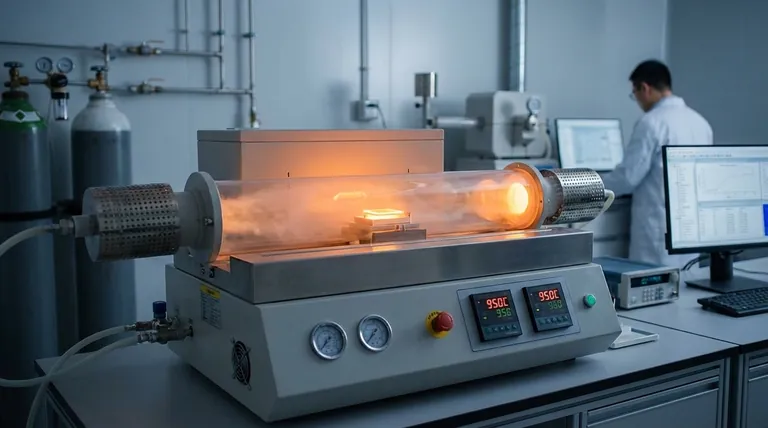Crucially, there is no single temperature range for Chemical Vapor Deposition (CVD). The required temperature is dictated entirely by the specific materials and chemical reactions involved, spanning from a few hundred degrees Celsius to well over 2000°C. For example, some processes operate between 800°C and 1051°C, while high-temperature furnaces can reach up to 2200°C for specialized, high-performance materials.
The core principle to understand is that CVD temperature isn't a machine setting; it's the thermal energy required to break down specific precursor gases and successfully deposit a high-quality thin film onto a substrate.

Why Temperature is the Critical Variable
The temperature inside a CVD reactor is the primary driver of the entire deposition process. It directly controls the chemical reactions and the quality of the resulting film.
Driving the Chemical Reaction
The fundamental goal of CVD is to use precursor gases to form a solid material on a substrate. These gases are stable at room temperature.
Applying high heat provides the necessary activation energy to break the chemical bonds within the precursor gases, allowing the desired atoms to deposit onto the substrate surface.
A Spectrum of Processes
The vast range in CVD temperatures reflects the vast range of materials it can create.
A process for depositing a coating on steel might run at 800-1050°C. In contrast, producing highly stable, high-performance materials like certain ceramics or carbon structures requires much more energy, with temperatures reaching up to 2200°C.
Influencing Film Quality
Temperature directly impacts the characteristics of the final deposited film.
Higher temperatures generally provide more energy to the depositing atoms, allowing them to arrange into a more ordered, crystalline, and dense structure. Lower temperatures might result in a more amorphous or less stable film.
Understanding the Trade-offs of High-Temperature CVD
While high temperatures are often necessary for high-quality films, they introduce significant constraints and challenges that must be considered.
Substrate Material Limitations
This is the most common and critical limitation. The substrate must be able to withstand the deposition temperature without melting, deforming, or degrading.
For instance, the typical 800-1050°C range for some coatings is higher than the tempering temperature of many steels. This means the process can alter the fundamental properties of the steel substrate itself.
Materials with low melting points, such as aluminum alloys, polymers, or certain glasses, are completely unsuitable for high-temperature CVD processes.
Energy Costs and Complexity
Maintaining temperatures over 1000°C, let alone 2000°C, requires specialized furnace technology and consumes a significant amount of energy. This directly increases both the capital investment and the operational cost of the process.
Process Safety and Handling
The precursor gases used in CVD are often toxic, flammable, or corrosive. High temperatures can increase the reactivity and volatility of these chemicals and their byproducts, demanding more stringent safety protocols and exhaust handling systems.
Making the Right Choice for Your Goal
The appropriate CVD temperature is determined by your end goal and, most importantly, the limitations of your substrate material.
- If your primary focus is creating high-purity, crystalline films (e.g., semiconductors, advanced ceramics): You must accept that high temperatures are often required and select a substrate material, like silicon or sapphire, that can tolerate the heat.
- If your primary focus is coating a heat-sensitive substrate (e.g., steel tools, aluminum components, polymers): You must investigate lower-temperature deposition technologies, such as Plasma-Enhanced CVD (PECVD), which uses an electric field to help break down gases at much lower temperatures.
Ultimately, successful deposition depends on matching the process parameters to the chemical requirements of the film and the physical limitations of the substrate.
Summary Table:
| CVD Process Type | Typical Temperature Range | Common Applications | Key Considerations |
|---|---|---|---|
| Standard CVD | 800°C - 1100°C | Coating steel, basic ceramics | May alter substrate properties; high energy use |
| High-Temp CVD | Up to 2200°C | Semiconductors, advanced ceramics | Requires specialized furnaces; substrate must tolerate extreme heat |
| Plasma-Enhanced CVD (PECVD) | 200°C - 400°C | Coating heat-sensitive materials (polymers, aluminum) | Lower temperature; uses plasma to activate reactions |
Ready to select the perfect CVD process for your specific material and application?
At KINTEK, we specialize in providing the right lab equipment and consumables to meet your precise CVD needs. Whether you're working with high-temperature ceramics or heat-sensitive substrates, our experts can help you choose the furnace and technology that ensures optimal film quality and substrate integrity.
Let's discuss your project. Contact our team today to get personalized recommendations and technical support for all your laboratory challenges.
Visual Guide

Related Products
- Customer Made Versatile CVD Tube Furnace Chemical Vapor Deposition Chamber System Equipment
- Split Chamber CVD Tube Furnace with Vacuum Station Chemical Vapor Deposition System Equipment Machine
- 1200℃ Split Tube Furnace with Quartz Tube Laboratory Tubular Furnace
- Vacuum Hot Press Furnace Heated Vacuum Press Machine Tube Furnace
- Rotary Tube Furnace Split Multi Heating Zone Rotating Tube Furnace
People Also Ask
- What are the methods of producing CNT? Scalable CVD vs. High-Purity Lab Techniques
- Are all lab grown diamonds CVD? Understanding the Two Main Methods
- Why are carbon nanotubes important in industry? Unlocking Next-Generation Material Performance
- How does chirality affect carbon nanotubes? It Determines If They Are Metal or Semiconductor
- What is the floating catalyst method? A Guide to High-Yield CNT Production



















